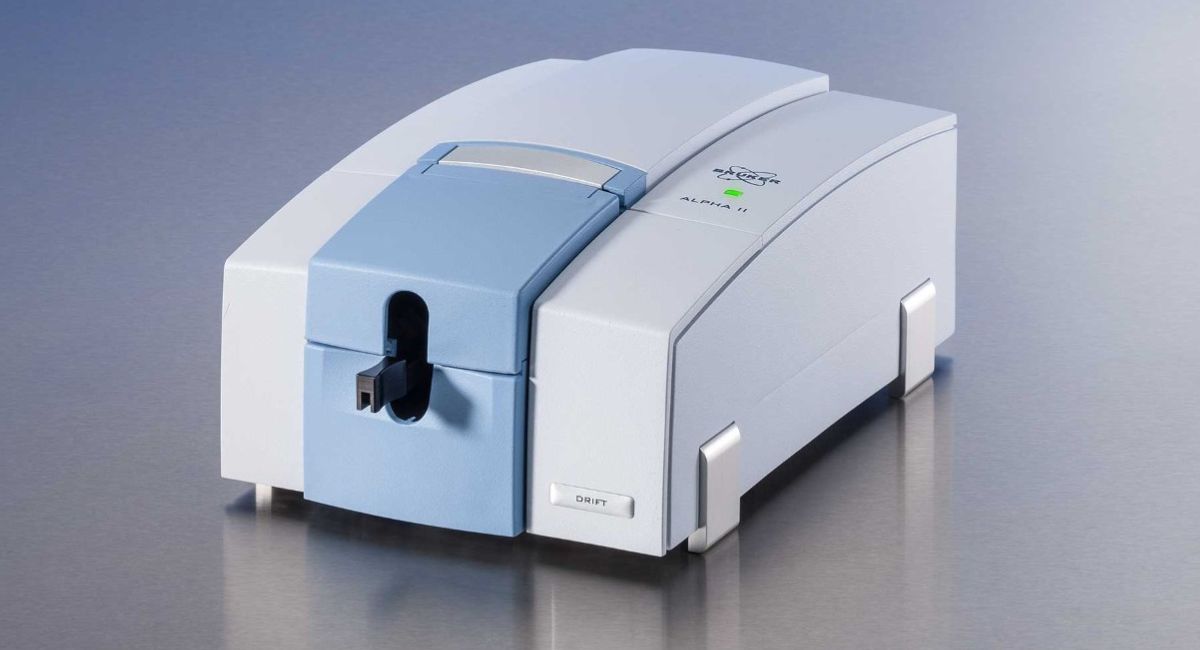FTIR Bruker
IR Spectroscopy: What Is It?
However, for historical reasons, we usually talk about infrared light in spectroscopy in terms of wavenumbers instead of wavelengths. Wavenumbers, which are expressed in cm-1 units, indicate the number of wavelengths per unit distance. Whereas light with longer wavelengths will have lower energy and wavenumbers, light with shorter wavelengths and more energy will have a bigger wavenumber.
Maintaining product quality, safety, and regulatory compliance in the intricate world of chemical production requires accurate and timely material identification. Material identification is crucial to preserving operating effectiveness and lowering risks, whether it is used to confirm the makeup of raw materials or guarantee the integrity of finished goods. The Bruker ALPHA II FTIR (Fourier Transform Infrared) Spectrometer is one of the most sophisticated devices made for this use. It is a vital instrument for quick material identification in the chemical industry because of its exceptional resilience, accuracy, and use.
Bruker FTIR Spectroscopy: Why Use It?
FT-IR spectroscopy is used in lab settings in practically every scientific field, including physics, chemistry, and the biological sciences. Pharmaceuticals, polymers, semiconductors, soil preservation, environmental research, art, conservation, and a host of other fields all employ FT-IR on a daily basis! There might be miles on the list.
However, why is that? These 10 factors explain why FT-IR is widely used in all contexts.
Simple to use
FT-IR spectroscopy is quite simple to master and practically anyone can do it.
All-encompassing
Powder, liquid, solid, semisolid & gases may all be analyzed using FT-IR spectroscopy.
Economical
When compared to other lab equipment (such as GC, LC, and XRD), the acquisition cost is minimal.
Reliable and repeatable
For optimal dependability and efficiency, FT-IR equipment is internally calibrated.
Time-efficient
Including data review and reporting, an analysis typically takes one minute.
Sustainable
FT-IR analysis does not utilize consumables, creates no waste, and is non-destructive.
Non-toxic and safe
FT-IR avoids potentially hazardous materials and radiation.
Worldwide accessibility
The sole requirements for FT-IR equipment are electrical power and a laboratory setting.
Minimal demand for space
Contemporary FT-IR equipment may fit into a laptop-sized space.
Useful for reverse engineering
The chemical makeup of any sample or product, even those of competitors, may be determined using FT-IR.
Why reflectance is used FT-IR In IR spectroscopy, a sample is exposed to infrared radiation, which causes an interaction between the sample and the light. A portion of the infrared light will be absorbed by the sample, while the remainder will be reflected off its surface. The infrared light that interacts with the sample and then passes through it is measured in transmission and ATR studies. On the other hand, light reflected from the sample surface is detected when a reflectance measurement is performed. Because of this distinction, reflectance is a great tool for examining samples that are challenging or impossible to study using transmission or ATR. Three different kinds of reflectance measurements are possible: reflection-absorption Spectral reflection dispersed reflection.
Reflection-Absorption, commonly known as “transflectance,” is comparable to measurement methods based on absorption. In this procedure, infrared light travels through the sample before reflecting off a reflective surface. For this approach, the sample must be extremely thin in order for the infrared light to adequately travel through it without being completely absorbed. Reflection from the stars The sample itself needs to be smooth and shiny in order to employ specular reflection, which simply reflects infrared light off the sample surface. Any reflective substance, including metal coatings, polymers, glass, minerals, and gemstones, can be analyzed using specular reflectance. Additionally, since this examination approach involves minimal physical contact, it is ideal for quickly identifying materials and evaluating artwork.
DRIFTS and diffuse reflectance
Specular reflectance measurements do measure diffuse reflection, but they require that there be no diffuse reflection when the sample is exposed to infrared light. Diffuse Reflectance Infrared Fourier Transform Spectroscopy (DRIFTS) is the name of this method. Using this method, the infrared light interacts with the sample and is then dispersed in all directions by the particles within the sample. Gold mirrors are used to gather the dispersed light before it is recognized.
It is simple to obtain high-quality FT-IR spectra for a variety of solid objects, including tissues, soils, and artwork, using these three reflectance measurement approaches. Since reflectance is not always the best method, it is also critical to comprehend transmission and ATR in order to select the best method for each sample.



